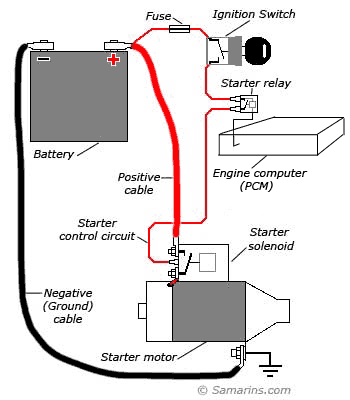Starting system, Starter motor
A starter is an electric motor that turns over the engine to start it.
A starter consists of the very powerful DC electric motor and the starter solenoid that is usually attached to the motor (see the picture).

A starter motor requires a very high current to crank the engine, that's why it's connected to the battery with large cables (see lower diagram).
The negative (ground) cable connects the "-" battery terminal to the engine cylinder block close to the starter.
The positive cable connects the "+" battery terminal to the starter solenoid.
The starter solenoid works as an electric switch - when actuated, it closes the circuit and connects the starter motor to the battery. At the same time, it pushes the starter gear forward to mesh with the engine's flywheel.
How the starting system works:
When you turn the ignition key to the "Start" position, the battery voltage goes through the starter control circuit and activates the starter solenoid, which in turn energizes the starter motor. The starter motor cranks the engine.
The starter motor can only be operated when the automatic transmission shifter is in the "Park" or "Neutral" position or, if the car has a manual transmission, when the clutch pedal is depressed.
To accomplish this, there is a Neutral safety switch installed at the transmission shifter or at the clutch pedal.
When the automatic transmission is not in "Park" or "Neutral" (or when the clutch pedal is not depressed), the neutral safety switch is open and the starter relay disconnects the starter control circuit.

The modern starter motor is either a permanent-magnet or a series-parallel wound direct current electric motor with a starter solenoid (similar to a relay) mounted on it. When current from the starting battery is applied to the solenoid, usually through a key-operated switch, the solenoid engages a lever that pushes out the drive pinion on the starter driveshaft and meshes the pinion with the starter ring gear on the flywheel of the engine.
The solenoid also closes high-current contacts for the starter motor, which begins to turn. Once the engine starts, the key-operated switch is opened, a spring in the solenoid assembly pulls the pinion gear away from the ring gear, and the starter motor stops.
The starter's pinion is clutched to its driveshaft through an overrunning sprag clutch which permits the pinion to transmit drive in only one direction. In this manner, drive is transmitted through the pinion to the flywheel ring gear, but if the pinion remains engaged (as for example because the operator fails to release the key as soon as the engine starts, or if there is a short and the solenoid remains engaged), the pinion will spin independently of its driveshaft.
This prevents the engine driving the starter, for such backdrive would cause the starter to spin so fast as to fly apart. However, this sprag clutch arrangement would preclude the use of the starter as a generator if employed in hybrid scheme mentioned above, unless modifications are made.
Also, a standard starter motor is only designed for intermittent use which would preclude its use as a generator; the electrical components are designed only to operate for typically under 30 seconds before overheating (by too-slow dissipation of heat from ohmic losses), to save weight and cost. This is the same reason why most automobile owner's manuals instruct the operator to pause for at least ten seconds after each ten or fifteen seconds of cranking the engine, when trying to start an engine that does not start immediately.
Charging system functions
n Recharges the battery after cranking the engine.
n Supplies electrical energy to the electrical system when the engine is running.
n Compensates for the changing electrical loads on vehicles battery or electrical system while the engine was not running
n Compensates for any electrical drain on the battery
n Act as a smoothing device to compensate for voltage irregularities.
Types Of Charging System
n DC Generator: (used on older cars)
§Conductor (Armature) is rotating
§Magnetic field (field coil) is stationary
§Same as normal starter motor minus the drive on the starters
§Complex voltage control: Needs cut out, voltage and current regulators
§If cut out doesn’t work it self destructs.
No comments:
Post a Comment